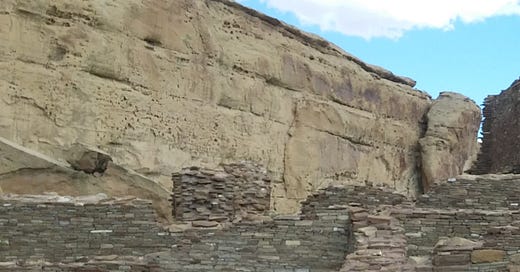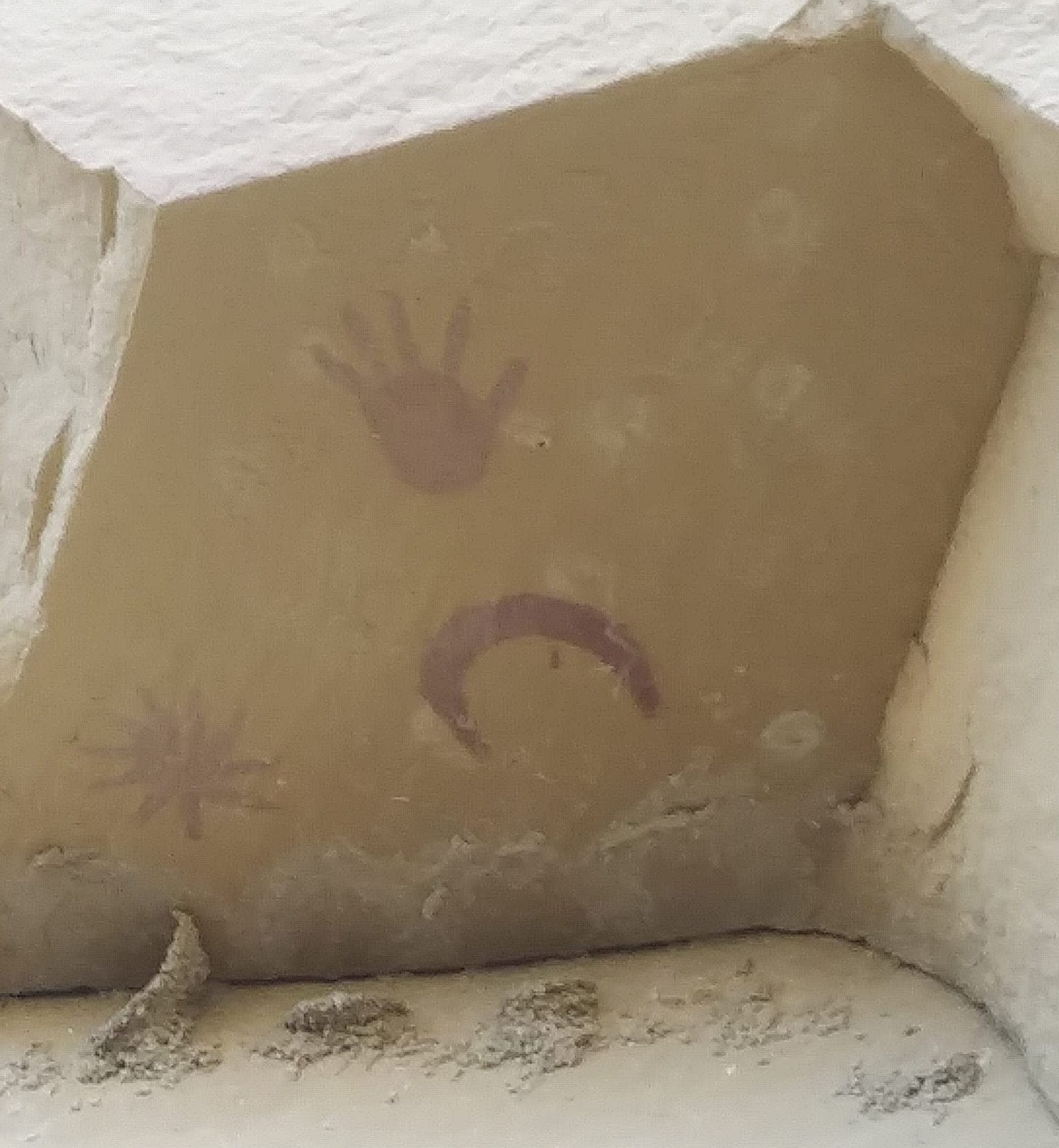A few years ago, Tom and I took a friend to Chaco, a National Historical Park in New Mexico that features miles of intact, ancestral-Puebloan buildings. Although Tom and I had been there many times before, it was a joy to show our friend the old sleeping and storage spaces in Chetro Ketl, the multistory building at the center of the ancient community, to duck through the low doors and read information from our guidebook about window placement, wall structures, and religious ceremonies.
With a few hours left before the park closed, we decided to walk a backcountry trail past cliff faces covered in petroglyphs. At the far end of the trail there was a pictograph1 I’d never seen that may depict the supernova of 1054 CE. The guidebook said it would take us four to six hours to complete the roundtrip hike, but the three of us power-walked through sagebrush and across washes to arrive at the head of a canyon in forty-five minutes. We saw a few unimpressive sun-shaped images scratched into the rock well above our heads. Then, on the ceiling of a large cleft high above us, I saw three red images: a sun like a child would draw, a crescent moon shape, and a handprint.
There is ample evidence the ancestral Puebloans studied the sky closely and were aware of the pattern of movement of the sun, moon, and stars throughout the year. They certainly would have recognized the supernova as something new and surprising in the sky; it was visible during the day for several weeks and at night for almost two years.
As I stared at the three simple drawings, I could almost see a young Puebloan man sitting up on his sleeping mat one summer evening in 1054. In my imagination, he’s scared, afraid his world will end suddenly and inexplicably, that his life will be taken just as it feels like it’s starting. He is a writer before his culture had a written language, so he tells his story in images—the bright new celestial object hanging in the sky next to the crescent moon.
“I was here,” he says to himself as he traces his hand and then carefully fills in the outline. “At one time, I existed.”
Scientists surmise that the sun shape in the pictograph was the supernova, and the moon shape recorded the phase of the moon at the time the supernova was brightest. However, the whole image was probably painted by a Sun-priest whose job it was to observe the sky.2 We know nothing of the thoughts or feelings of this person, but as I stood with my neck craned backward, I identified so strongly with the ancient writer/artist I could almost see him painting with the same intensity I write in my journal.
“I understand,” I told the shadowy figure.
In my imagination, he glanced over his shoulder, and for a split second, our eyes met. I saw my fear of the unknown in his worried face, and although we were separated by almost 1,000 years, we bonded across time.
We only stayed at the pictograph for a few minutes before we retraced our steps at top speed to get back to the car and out of the park before closing time, but they were a powerful few minutes. It was the middle of the pandemic, a time filled with sickness and death, fear and doubt, distrust and hostility. Now, when the world is faced with different uncertainties—wars, political shifts, and fires, floods, and storms that have devastating effects on humanity—I build on my story about the worried person I imagined. What else was going on in his world at the time the supernova appeared in the sky? Experts think that Chaco was something like our modern-day convention centers, a place where people gathered periodically to trade or celebrate. Did the leaders call a Puebloan conference to discuss the new celestial object? Was the community buzzing, wondering and worrying out loud the same way we talk today about the fires in LA, the hurricanes in Florida, and the record setting heat in Europe?
I want to think so because it gives me perspective on my own concerns. The details are different, but it comforts me to recognize that underneath, our experiences are similar, that people throughout time have looked at what’s happening around them and have realized, “I don’t know what’s going to happen next,” and so they paint, or write, recording their experiences and signing the result with a handprint or a signature: I was here, I lived.
Sarah Savage
Petroglyphs are carved, chipped, or ground into rock surfaces using handheld rock tools. Pictographs are painted or blown onto rock surfaces using brushes, stencils, and other tools. https://www.nps.gov/articles/000/upload/LookPetroglyphsPictographs_508.pdf
https://www.worldhistory.org/Chaco_Canyon/






"...he tells his story in images." A reminder for each of us, right? To tell the stories we can for as long as necessary. To weave together what it means to be here now with the same wonderment of what happens next. To keep the history as a reminder, not a forgotten relic.
I love the final summarisation you make here Sarah, " “I don’t know what’s going to happen next,” and so they paint, or write, recording their experiences and signing the result with a handprint or a signature: I was here, I lived."
Whether we live small private lives, or are hounded by journalists and paparazzi, whether we are a poor hungry tribe or aristocrats we are important and as such any written words describing those lives is equally so. We were here, we lived like this...
Thank you so much for sharing. 🙏🏼